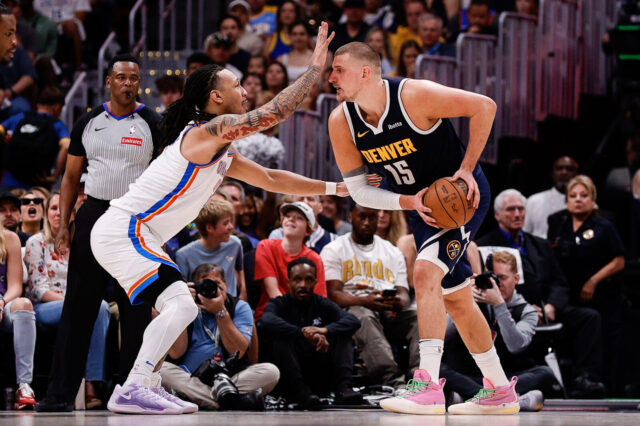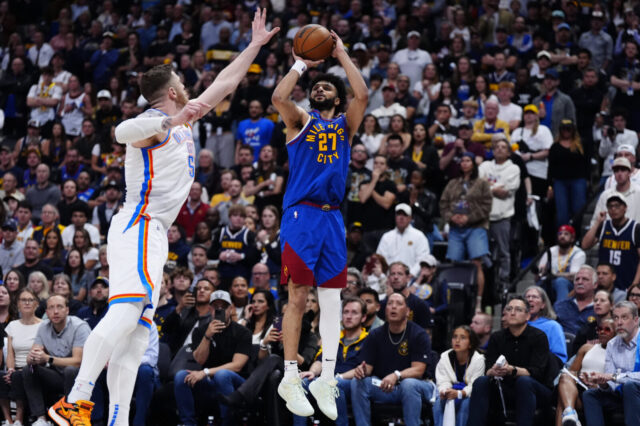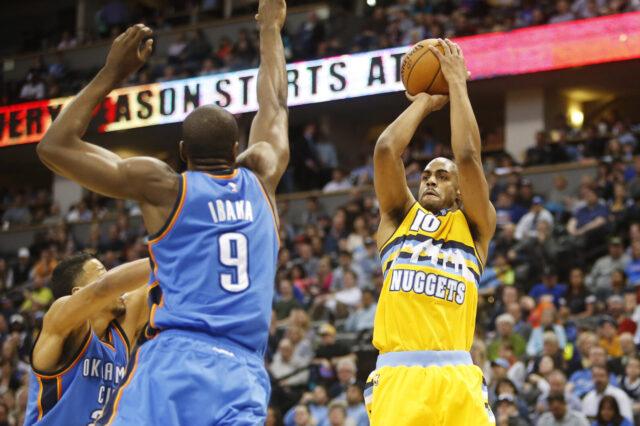What are some of the first things you think of when you think of Oklahoma?
Tornadoes, right? Maybe it’s Native Americans, oil, cattle, country music, or college football.
It’s a nice place to live, with an unique culture that is hard to understand if you haven’t spent much time there. The weather can feel like it’s trying to erase you from the earth sometimes, and yes, the winds do come sweeping down the plains.
But you may not know it as the place where stars like Carrie Underwood, Ron Howard, Vince Gill, Kristin Chenowith, Reba McEntire, Garth Brooks, Kathy Lee Gifford, and Brad Pitt were born. While they may not live there now, they can’t change where they came from, and they’ll always have a bit of the heartland as a part of them.
To switch things over to the NBA side, the state has produced some fine basketball players too. Some of you may remember John Starks (born in Tulsa) or Big Country Bryant Reeves (born in Gans), while current fans have heard of Blake Griffin (born in Oklahoma City) and they are starting to hear about Trae Young, the Sooners guard that is in the running for the Naismith Award (born in Lubbock, TX but raised in Norman).
It may be time to start hearing what Malik “Shake” Milton has to say when it comes to playing basketball as well.
Shake’s father, Myrion, played basketball for Texas A&M, and passed on his love of the game to his son. Tragically, Myrion passed away during Shake’s freshman year of high school, at the age of 43, but was able to teach his son principles about life and the game they loved that stick with him to this day.
“He was like my best friend. He was a basketball nerd, too, so we would just sit there and watch basketball together,” Milton said in an interview in 2015. His father would tell his son, “Every time you walk out on the floor, you have to know you’re the man and that no one else can stop you and no one else can play with you.”
While Myrion was a forward back in his playing days, he taught his son how to be a lead guard, developing his handle and teaching him how to run an offense.
“My dad used to make me put these goggles on where I couldn’t look down at the ball and made me dribble over and over again,” Milton said.
The lessons have paid off. In Milton’s third year at SMU, he’s taken over the point guard role for the Mustangs. Milton is averaging 18.0 points, 4.7 rebounds, and 4.4 assists per game, and he doesn’t have much help, with Jarrey Foster, a fellow NBA prospect, out for the season with a partially torn ACL.
The Mustangs have been a fun team to watch over the last few seasons. Milton was able to play with Sterling Brown (Bucks) and Semi Ojeleye (Celtics), and the Mustangs like to switch everything and play a high-energy man-to-man defense. This season, Milton will matchup against point guards, but can switch onto forwards thanks to his 6-foot-5-inch frame and reported 6-foot-11-inch wingspan. SMU also loves to run ballscreen offense, getting Milton into opportunities to score in the pick and roll or kick out to 3-point shooters. SMU is not a team that can dump the ball into a big and let him bash home points – their tallest player, Ethan Chargois at 6-foot-9-inches, takes half of his shots from behind the arc and shoots 40 percent on his 3-point attempts.
One of Milton’s strengths is his ability to navigate into the paint, draw contact, and get to the free throw line to score. While everyone calls him Shake, he has a very loose, smooth, relaxed pace to his game. He has a 40 percent free throw rate, according to Basketball Reference, where he shoots nearly 85 percent. His field goal percentage at the rim is down this season, to 48.3 percent from 56.5 percent last year, according to Hoop Math, but that doesn’t change the fact that he’s able to get open inside the arc on a consistent basis.
Milton also has a strong probability of being a good defender in the NBA. We’ve already seen two former SMU players do well on that end in the NBA in Brown and Ojeleye, and Milton has been getting the same instruction. He’s able to disrupt passing lanes thanks to his knowledge of the game and his crazy long arms, and he does a great job closing out on shooters or harassing someone in isolation thanks to his physical gifts. He’s also an adept rebounder, among the top defensive rebounders that I am tracking this season.
Milton has great vision in the pick and roll. I watched his game against Wichita State to see how he would do against a NBA prospect in Landry Shamet, and there were many plays where Milton showed patience, keeping his dribble and passing lanes open after receiving a screen, and popping up to hit the roll man for an easy basket at the rim.
I don’t have access to Synergy stats, but I do know that Milton has shot above 40 percent on 3-pointers every year he’s been at SMU. He’s got a nice, easy off the dribble shot he can pull out if the defender goes under the screen, and has a nice base when he’s shooting off the catch. With his height and wingspan, it makes it difficult for opposing guards to truly contest his jumpshot. If the opposing team tries to guard him with a forward, he gets his man off balance with a pump fake and then is able to navigate into the paint, where he draws a foul.
I’d be remiss if I didn’t mention his defensive talent as well. The Mustangs are able to switch on defense because of players like Milton, who can pounce into passing lanes and disrupt taller players’ shots with his prodigious wingspan. At 205 pounds, he doesn’t have the mass to defend power small forwards like Jayson Tatum or LeBron James, but as a combo guard, he can at least hassle them into exhausting themselves getting post position.
I am a little concerned about his ballhandling ability. It’s really difficult for players his height to have a tight dribble, and it opens a possibility for defenders to slap the ball away from him when he’s driving. He’s shown an ability to get into the paint regardless, and has a variety of moves to counter whatever defensive actions are thrown at him. If a defender reaches for the ball, they have a long way to go, and he’s comfortable just pulling up to get up a jumper if a defender reaches.
There are athleticism concerns, because his smooth game can seem to be low energy at times. He’s not going to be a Dennis Smith Jr. or Russell Westbrook type of player, bursting through the defense like a combine hitting a wheat field. There are enough pros that have similar games though – Caris LeVert, Shaun Livingston, and Steve Smith come to mind – that it doesn’t seem like it’ll be an issue, as long as he learns how to use his length. It’s not like his arms are going to get any shorter.
While his future role in the NBA is uncertain – is he a point guard? A shooting guard? A backup? – I think he’s a player that the Nuggets should give a closer look to. He’s not a true, veteran point guard, but he has the defensive talent and offensive tools to be a bench contributor for a long time. The Nuggets really could look into a backup point guard in the draft, and Milton might be able to learn that position better and develop into that type of prospect. In the immediate, think of him as a taller, more accurate shooting version of Torrey Craig.
I’ve seen Milton as a lottery pick on some sites,or going in the 20-30 range for some mock drafts. I have him rated as my No. 4 point guard on my Big Board, behind Landry Shamet and before De’Anthony Melton. The Nuggets could easily find themselves in a position to take on of Shamet, Milton, or Melton with their first round pick if they decide to keep it.
Milton is one of my favorite prospects. He’s got that unique size and wingspan, a high basketball IQ, and has a ceiling of a five-tool player. He’s a true two-way prospect, and he’s comfortable as the primary option or being the third or fourth option. I’m not even worried that he has Kenneth Faried levels of skinny legs, there’s just more room for him build up strength while also developing into his body.
This content is no longer available.


